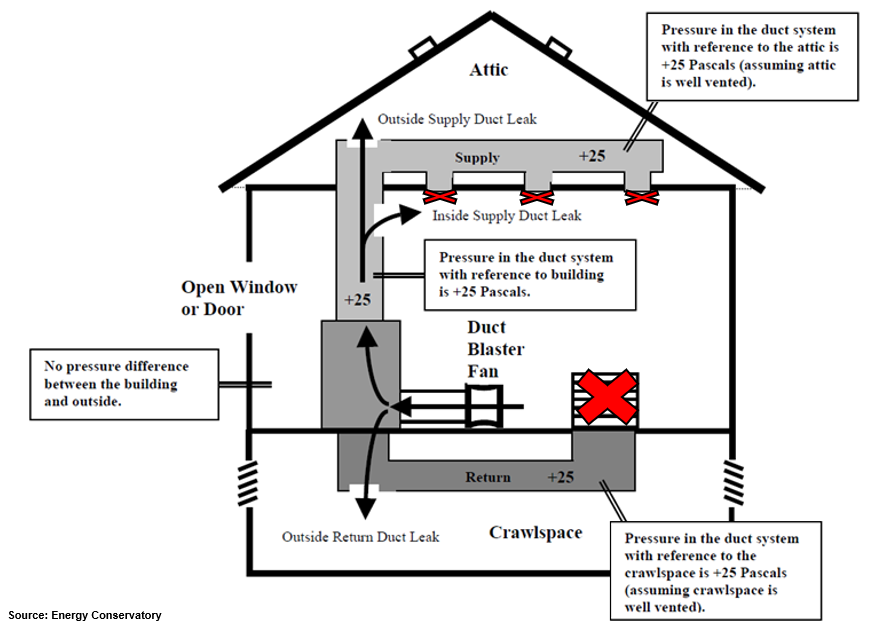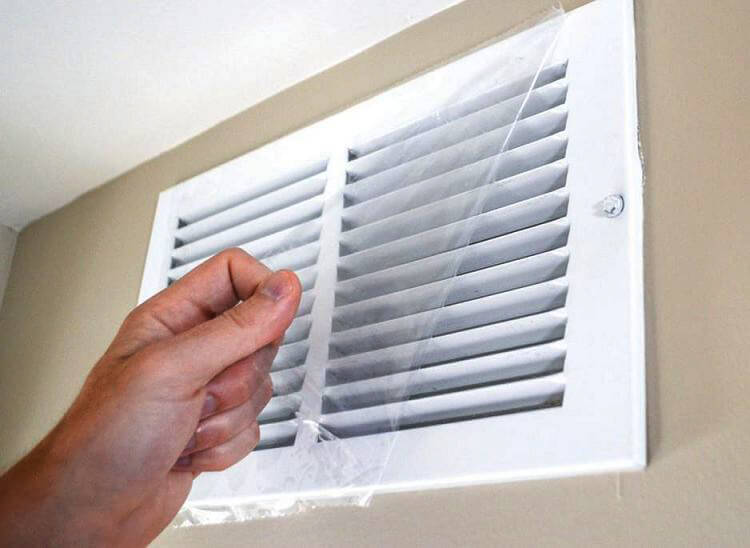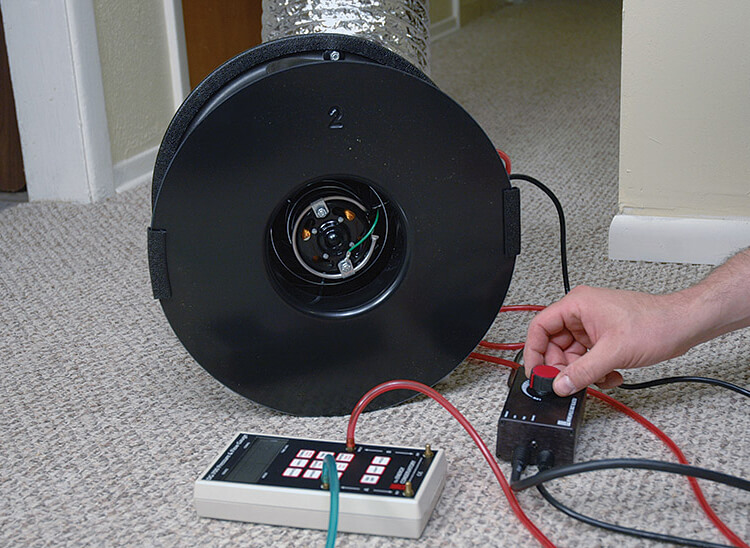Duct Leakage Testing

Duct Leakage Testing
Everything you need to know about a duct leakage test.
A duct leakage test measures the airtightness of your ducts. This test is incredibly useful for improving your home’s energy consumption and saving you a lot of money on your energy bills. It might be the best thing you ever do for your home.
The purpose of the test is to ensure that the amount of air escaping from the unit or the ductwork outside the building envelope is minimal and working efficiently.
Special fans calibrated to measure the airflow in your ducts can tell you a lot about what’s behind your walls. Not only will air leakage in your ducts lead you to spend more on your energy bills, but it can also spread dust and harmful fumes throughout your home.
How is a duct leakage test conducted?
A duct leakage test, also known as a duct blaster test, doesn’t take much time to complete. They typically last anywhere from 1 to two hours, depending on your ductwork’s complexity and size. You can stay in the home while the test is being conducted, providing minimal disturbance to your daily routine.
Before the test, a minimally invasive fan called a duct blaster is installed on one of your ducts. The fan is used to create negative pressure in your vents and track any ventilation changes when paired with a pressure sensor. A duct blaster only creates a small amount of pressure needed to pull air through leaks and come up with the necessary measurements.
Before depressurizing your vents, all openings are sealed to help maintain the pressure and accurately detect the system’s changes. The information gathered from the test will also tell you the volume of air being lost. Using this information, you’ll know exactly how much air you’re losing and even where you are losing it.


What is a passing duct leakage test score?
After your duct leakage test, a certified technician will score your ducts with a CFM per 100 square feet per conditioned space. CFM stands for cubic feet per minute. To receive a passing score, your system should measure under 4 CFM per 100 square feet with the air handler installed or 3 CFM without the air handler installed.
This means you’re losing 4 cubic feet of air per 100 square feet of conditioned space. It’s normal to lose some air in your ducts. It’s estimated that 30% of the air we pay to heat and cool is leaked out of your ductwork. If you score over 4 CFM, you may need to make some repairs or improvements to your system.
If you don’t pass your duct blaster test, your HVAC system may be running overtime, and leaked air could be spreading allergens and fumes throughout your home. When leakages are left unchecked, it could cause damage to your system and a frequent need for repairs. It also creates hot and cold spots throughout your home, making you and your family uncomfortable.
Why do I need a duct leakage test?
If any part of your HVAC system, such as the air handler or ductwork is sitting outside, you may be required to run a duct leakage test. According to the 2015 IECC or the International Energy Conservation Code, all new residential units must pass this test.
A duct blaster test is also a great way to pinpoint areas you need to repair or improve upon, isolating the problem and allowing you to focus your efforts where they matter most. It will help you save money when you’re renovating for greater energy efficiency.
Leaks in your ductwork can also be harmful to you and anyone who lives in your home, allowing dust and other allergens to circulate. This can aggravate allergies, cause great discomfort, and potentially be hazardous to you and your family.
The benefits of a duct blaster test
- Protect your family from outside contaminants
- Increase the energy efficiency of your home
- Get more out of your HVAC system
- Save money on repairs
- Prevent hot and cold spots
- Isolate problems invisible to the eye
- Increase the resale value of your home
- Follow state regulations
How to pass a duct leakage test:
Seal leaks with long-lasting solutions, not temporary fixes. Use insulation that is long-lasting and equipped to deal with the demands of frequent usage.
Make sure to clean your ducts before you begin sealing them. This ensures that any debris or lose particles that made their way into your system don’t cause issues down the road.
Use mastic over tape. This gives you more protection and longevity in the integrity of your ductwork. Tape alone will break down over time, leading to repeat leakages. Mastic in combination with tape is a permanent solution.
Hire professionals to seal your ducts. There are leakages you won’t be able to see or access on your own. Professionals can use their equipment to glue the insides of your ducts efficiently, covering areas that are hard to access.
Keep your system up to date. Older ductwork is notorious for leakages. The frequent heating and cooling that causes expansion and contraction in your ducts create tiny holes in seals and joints.
Proactively seal areas even when you don’t find leaks. The only thing holding your ducts together are metal bands, and they’re not air-tight. By proactively sealing these areas, you can prevent leakages and increase the airtightness of your system.
Getting a duct leakage test is easy!
Ready to get a duct leakage test in your home? Getting a test is easy and essential for your plans to make your home more energy-efficient, ready to sell, and more comfortable for residents living in your home. Don’t wait until you think something is wrong with your ductwork to get a test. You can save yourself a lot of money and time down the road.
Ductwork Testing is a veteran-owned business that prides itself in providing quality service to our customers in the Philadelphia area. Scheduling an appointment or consultation is easy. If you have any questions or are interested in conducting a duct leakage test in your home, call us during our regular business hours or email us.

We seal off all registers and returns with a vent cover film.

We connect a fan to the air handler or a central return

We use a gauge to measure the duct pressure and the amount of air pressure flowing through the fan.

What happens if the duct leakage test is a pass?
We will immediately issue you the required paperwork to submit to your building inspector.

What happens if the test is a fail?
If the test is a fail we can revese the machine and put pressure into the ducts locate the leaks and additionally seal the ductwork, and the unit itself and try for a second time.
Although we cannot guarantee a pass after this service we do have a near perfect record of achieving the state minimum requirements.